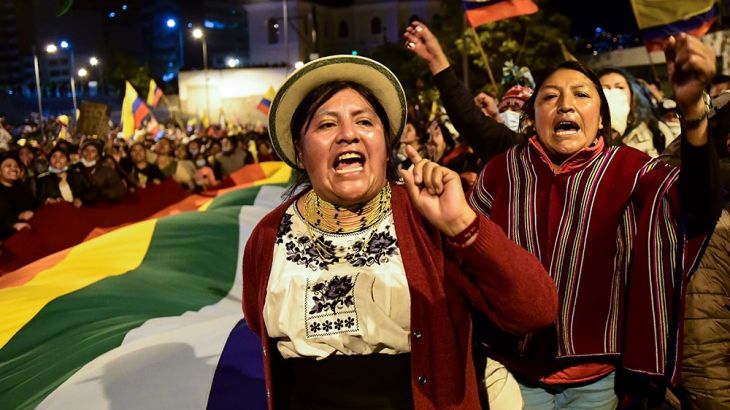
How unpaid corporate taxes led to violent protests in Ecuador
Why corporate tax cuts and austerity plans are behind Ecuador’s violent protests. Plus, effects of Japan’s ‘Abenomics’.
A rebellion against inequality, austerity and the politics of “more of the same” is growing in Latin America and is springing from what looks like the most innocuous changes.
It is not dissimilar to uprisings elsewhere.
Keep reading
list of 4 itemsUS imposes new sanctions on Iran after attack on Israel
A flash flood and a quiet sale highlight India’s Sikkim’s hydro problems
Why is Germany maintaining economic ties with China?
In Chile, the rise of train fares led to street protests and calls for an end to neoliberalism. In Argentina, a sitting president was voted out of power after a protest over austerity measures imposed by the International Monetary Fund (IMF) as a condition of a $57bn bailout.
And in Ecuador, it was the IMF’s involvement which forced the president and cabinet to escape the capital Quito. The size of the IMF bailout was similar to the size of unpaid corporate taxes, as highlighted by former economy minister Wilma Salgado. Ecuador requested a $4.2bn loan from the IMF and a condition of that was to cut the budget deficit.
The Ecuadorian government decided to cut fuel subsidies, which were costing $1.3bn a year. But the decision led to protests, forcing the government to walk back the proposal. Still, the government pressed ahead to wipe out much of the taxes owed by Ecuadorian corporations.
Otaviano Canuto, a senior fellow at the Policy Center for the New South who has also held roles at the IMF and the World Bank, tells Al Jazeera that the scrapping of fuel subsidies had differentiated impacts on the social structure in Ecuador.
“Cutting the fuel subsidies, paradoxically, while in some other countries it might benefit particularly the poor, because as long as it is accompanied by compensatory social policies, the fact is that the major beneficiaries very often are the middle classes who use cars, who benefit from the oil subsidies and so on,” Canuto says.
“But in the case of Ecuador, apparently the burden is split between the fractions of the population. I know for one that the preference of the IMF, for instance, was on adjusting value-added taxes, not attacking the fuel subsidies.”
Has Shinzo Abe’s economic policy helped Japan recover from its lost decades?
On November 20, Shinzo Abe served his 2,887th day in office, making him the longest-serving prime minister in Japanese history.
But Abe’s first term lasted only a year. He quit amid accusations that he violated electoral laws. And there were five other prime ministers between his first and second terms, all of which only lasted about a year each.
At the start of his second term in 2012, Abe’s namesake economic policy grabbed the attention of economists and policymakers.
Japan‘s economy was struggling with deflation and slowing growth after a stock market and property crash in the 1990s. And Abe promised to combat the slow growth with a three-pronged economic plan, known as “Abenomics”.
The plan involved the Bank of Japan using its powers to buy government bonds and stocks. The second step of the plan was to increase infrastructure spending and the third was to make structural changes to the world’s fourth-largest economy.
For the most part, economists have said the policy has been a failure. But questions have also been raised about his over-friendly relationship with US President Donald Trump, who finally delivered a trade deal that avoided a protracted trade war.
Takuji Okubo, managing director of Japan Macro Advisors, notes that Abe has implemented several important economic policies but has also benefitted from a bit of luck.
“He has been lucky in the sense that the global economy has not had a major recession in the past 10 years so that has been a very favourable environment for Japan’s economy to prosper.”